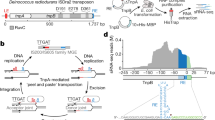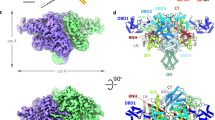Abstract
Transposable elements from prokaryotic and eukaryotic organisms are discrete DNA segments bounded by inverted or directly repeated sequences that insert into non-homologous DNA in a reaction that is independent of the general recombination functions of the host. The mechanisms proposed generally involve a staggered double-stranded scission of the target DNA, ligation to the nicked ends of the transposable element, and replication of the element, resulting in the generation of a directly repeated oligonucleotide target sequence flanking the new copy of the element1–3. Most transposons have a relatively low degree of target site specificity coupled with a low insertion frequency. Tn554, a Staphylococcus aureus transposon which specifies resistances to erythromycin and spectinomycin, displays an unusually high degree of insertion specificity. Tn554 transposes with high efficiency to a unique (‘primary’) site in the S. aureus chromosome4,5 and only rarely (<10−6 per transductant) to other, secondary sites6. We report here the nucleotide sequences surrounding the junctions of Tn554 in three independent ‘primary’ insertions and two ‘secondary’ insertions of the transposon. Two unusual features are revealed: first, the termini of Tn554 contain neither inverted nor directly repeated sequences. Second, transposition of Tn554 does not generate the short direct repeats of the target DNA that are characteristic of other transposable elements. These results suggest that the mechanism of Tn554 insertion may be significantly different from that of other transposons.
This is a preview of subscription content, access via your institution
Access options
Subscribe to this journal
Receive 51 print issues and online access
$199.00 per year
only $3.90 per issue
Buy this article
- Purchase on Springer Link
- Instant access to full article PDF
Prices may be subject to local taxes which are calculated during checkout
Similar content being viewed by others
References
Shapiro, J. A. Proc. natn. Acad. Sci. U.S.A. 76, 1933–1977 (1979).
Grindley, N. & Sherratt, D. Cold Spring Harb. Symp. quant. Biol. 45, 125–134 (1980).
Kleckner, N. A. Rev. Genet. 15, 341–404 (1981).
Phillips, S. & Novick, R. P. Nature 278, 476–478 (1979).
Krolewski, J., Murphy, E., Novick, R. P. & Rush, M. G. J. molec. Biol. 152, 19–33 (1981).
Murphy, E., Phillips, S., Edelman, I. & Novick, R. P. Plasmid 5, 292–305 (1981).
Lichtenstein, C. & Brenner, S. Molec. gen. Genet. 183, 380–387 (1981).
Barth, P. T., Datta, N., Hedges, R. W. & Grinter, N. J. J. Bact. 125, 800–810 (1976).
Kamp, D. & Kahmann, R. Cold Spring Harb. Symp. quant. Biol. 45, 329–336 (1980).
Lichtenstein, C. & Brenner, S. Nature 297, 601–603 (1982).
Marmur, J., Falkow, S. & Mandel, M. A. Rev. Microbiol. 17, 329–372 (1963).
Nash, H. A. Rev. Genet. 15, 143–167 (1981).
Berg, D. Proc. natn. Acad. Sci. U.S.A. 80, 792–796 (1983).
Liebhart, J. C., Ghelardini, P. & Paolozzi, L. Proc. natn. Acad. Sci. U.S.A. 79, 4362–4366 (1983).
Akroyd, J. E. & Symonds, N. Nature 303, 84–86 (1983).
Allet, B. Cell 16, 123–130 (1979).
Kahmann, R. & Kamp, D. Nature 280, 247 (1979).
Chaconas, G., Harshey, R. M., Sarvetnick, N. & Bukhari, A. I. J. molec. Biol. 150, 341–359 (1981).
Harshey, R. M. Proc. natn. Acad. Sci. U.S.A. 80, 2012–2016 (1983).
Grunstein, M. & Hogness, D. S. Proc. natn. Acad. Sci. U.S.A. 72, 3961–3965 (1975).
Novick, R. P., Murphy, E., Gryczan, T. J., Baron, E. & Edelman, I. Plasmid 2, 109–129 (1979).
Maxam, A. M. & Gilbert, W. Meth. Enzym. 65, 499–560 (1980).
Author information
Authors and Affiliations
Rights and permissions
About this article
Cite this article
Murphy, E., Löfdahl, S. Transposition of Tn554 does not generate a target duplication. Nature 307, 292–294 (1984). https://doi.org/10.1038/307292a0
Received:
Accepted:
Issue Date:
DOI: https://doi.org/10.1038/307292a0
This article is cited by
-
Host range of strand-biased circularizing integrative elements: a new class of mobile DNA elements nesting in Gammaproteobacteria
Mobile DNA (2023)
-
A soil bacterial catabolic pathway on the move: Transfer of nicotine catabolic genes between Arthrobacter genus megaplasmids and invasion by mobile elements
Journal of Biosciences (2020)
-
Genetic basis for molecular epidemiology of MRSA
Journal of Infection and Chemotherapy (1996)
-
Distribution and characterization of plasmid-related sequences in the chromosomal DNA of different thermophilic Methanobacterium strains
Molecular and General Genetics MGG (1993)
-
Nisin biosynthesis genes are encoded by a novel conjugative transposon
Molecular and General Genetics MGG (1991)
Comments
By submitting a comment you agree to abide by our Terms and Community Guidelines. If you find something abusive or that does not comply with our terms or guidelines please flag it as inappropriate.



